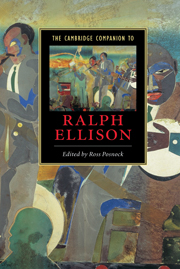Book contents
- Frontmatter
- Introduction
- 1 Ralph Ellison’s invented life
- 2 Ellison and the black Church
- 3 Ellison, photography, and the origins of invisibility
- 4 Ralph Ellison’s music lessons
- 5 Ralph Ellison’s constitutional faith
- 6 Ralph Ellison and the politics of melancholia
- 7 Invisible Ellison
- 8 Ellison’s experimental attitude and the technologies of illumination
- 9 Female iconography in Invisible Man
- 10 Chaos not quite controlled
- 11 Ralph Ellison, Hannah Arendt, and the meaning of politics
- 12 Dry bones
- Selected bibliography and suggestions for further reading
- Index
- Series List
8 - Ellison’s experimental attitude and the technologies of illumination
Published online by Cambridge University Press: 28 May 2006
- Frontmatter
- Introduction
- 1 Ralph Ellison’s invented life
- 2 Ellison and the black Church
- 3 Ellison, photography, and the origins of invisibility
- 4 Ralph Ellison’s music lessons
- 5 Ralph Ellison’s constitutional faith
- 6 Ralph Ellison and the politics of melancholia
- 7 Invisible Ellison
- 8 Ellison’s experimental attitude and the technologies of illumination
- 9 Female iconography in Invisible Man
- 10 Chaos not quite controlled
- 11 Ralph Ellison, Hannah Arendt, and the meaning of politics
- 12 Dry bones
- Selected bibliography and suggestions for further reading
- Index
- Series List
Summary
The year following the 1952 publication of Invisible Man, at the presentation ceremony for the National Book Award he had just won, Ralph Ellison told his audience that if he were asked in all seriousness what he considered to be the chief significance of Invisible Man as a fiction, he would reply, first, ''its experimental attitude'' and, second, ''its attempt to return to the mood of personal moral responsibility for democracy which typified the best of our nineteenth century fiction.'' That his first novel had won such an award he acknowledged as a clear sign of crisis in the American novel, a sense of crisis that he and the other ''younger novelists'' of the time shared.
On the aesthetic level, Ellison’s experimental novel had proceeded from his own reaction to a growing uncertainty about the formal possibilities of the novel – an uncertainty that led him to reject both the forms of the ‘‘tight, well-made Jamesian novel’’ and the ‘‘hard-boiled novel’’ of Hemingway, which had been a center of literary revolt among apprentice writers of the 1930s (Shadow 178–9). The narrative experiment that Ralph Ellison created to fill the void moved consciously ‘‘from naturalism to expressionism to surrealism,’’ from the world of ‘‘facts’’ to the world of dream and nightmare, from the determined to the disordered.
- Type
- Chapter
- Information
- The Cambridge Companion to Ralph Ellison , pp. 157 - 171Publisher: Cambridge University PressPrint publication year: 2005
- 1
- Cited by



